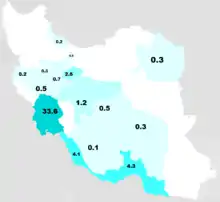Iranian Arabs
Iranian Arabs (Arabic: عرب إيران ʿArab Īrān; Persian: عربهای ايران Arabhāye Irān) refers to citizens of Iran who are ethnically Arab. In 2008, Iranian Arabs comprised about 2 percent of Iran's population, or about 1.6 million people,[1] and are primarily located in Khuzestan Province.[3]
| Total population | |
|---|---|
| ~1.6 million[1] (2008, est.) | |
| Regions with significant populations | |
| Khuzestan, Khorasan, Hormozgan, Bushehr, Qom | |
| Languages | |
| Arabic (Khuzestani Arabic, Khorasani Arabic, Gulf Arabic), Persian | |
| Religion | |
| Twelver Shi'a Islam (majority), Sunni Islam (minority)[2] | |
| Related ethnic groups | |
| Arabs (Ahwazi Arabs, Khamseh Arabs, Marsh Arabs, Arabs in Khorasan), Iraqis, Kuwaitis, Bahranis |

Overview
For centuries, Iranian rulers maintained contacts with Arabs outside their borders, dealt with Arab subjects and client states such as those of Iraq and Yemen, and settled Arab tribesmen in various parts of the Iranian plateau. The Arab expedition to Iran began before the Muslim conquests and continued with joint exertions of the civilized Arabs (ahl al-madar) and desert Arabs (ahl al-wabar).[4]
According to the Minorities at Risk Project 2001, about 40 percent of Arabs are unskilled workers living in urban areas. The Arabs in the rural areas are primarily farmers and fishermen. The Arabs living along the Persian Gulf coastal plains are mostly pastoral nomads. Tribal loyalties are strong among rural Arabs, but also have an influence in urban areas, impacting Arab socialisation and politicisation.[5]
In 2008, Payame Noor University made Arabic the second language of its 229 campuses and that its services would be offered in Arabic and Persian.[6]
History
Shapur II the Great (309–379 A.D.) of the Sassanid Empire, after a punitive expedition across the Persian Gulf early in his reign, transplanted several clans of the Taghleb to Dārzīn (Daharzīn) near Bam, several clans of the Abd al-Qays and Tamīm to Haǰar (the Kūh-e Hazār region) southeast of Kermān, several clans of the Bakr ben Wāʾel to Kermān, and several clans of the Hanzala to Tavvaz, near present-day Dālakī in Fārs.[7]
Although after the Arab conquest of the Sassanid Persian empire in the 7th century, many Arab tribes settled in different parts of Iran, it is the Arab tribes of Khuzestan that have retained their identity in language, culture, and Shia Islam to the present day. But ethno-linguistic characteristics of the region must be studied against the long and turbulent history of the province, with its own local language khuzi, which may have been of Elamite origin and which gradually disappeared in the early medieval period. The immigration of Arab tribes from outside the province was also a long-term process. There was a great influx of Arab-speaking immigrants into the province from the 16th to the 19th century, including the migration of the Banu Kaab and Banu Lam. There were attempts by the Iraqi regime during the Iran–Iraq War (1980–88) to generate Arab nationalism in the area but without any palpable success.[8]
Genetics
Sampling NRY diversity, it was determined that the Y-DNA haplogroups F and J2 are carried at high frequency among the Iranian Arabs, accounting for more than half of Iranian Arab haplogroups.[9] The high ratio of haplogroup F genetically relates Iranian Arabs to Eastern Mediterraneans and the people of the Barbary Coast. An elevated frequency of haplogroup J-M172 is typical of Near Eastern people and reflective of the genetic legacy of early agriculturalists in the Neolithic Near East c. 8000–4000 BCE.[10][11][12] Haplogroup R1a1, and R1, typical of Indo-Iranian groups, occurred in more than 11 percent of the sample and haplogroup G was present in more than 5 percent.[9]
Regional groups

Khuzestan
Most Iranian Arabs in Khūzestān Province speak Arabic and Persian. The Arabic spoken in the province is Khuzestani Arabic, a Mesopotamian dialect shared by Arabs across the border in Iraq.
From the immigrant Arab tribes of Khuzestan, the Banu Kaab at Dawraq, the later Fallāhīya and present-day Shadegan, and the Mawlāʾī at Hoveyzeh can be mentioned.[13]
The Bani Turuf tribe is settled in the Dasht e Azadegan (formerly Dasht-e Mīshān) around the town of Hūzagān (formerly Hoveyzeh), and consists of seven tribes, the Sovārī, Marzaā, Shorfa, Banī Sāleh, Marvān, Qāṭeʿ, and Sayyed Nemat. North of the lands of the ʿAnāfeja of the Āl Katīr, in the area called Mīānāb, between the Kārūn and Karkheh Rivers, dwell several Arab tribes, of which the best known are the Kaab (probably an offshoot of the Banī Kaʿb of southern Khuzestan), the ʿAbd al khānī, the Mazraa, the Al Bū Rāwīya, and the Sādāt. These tribes gradually immigrated into Iran during and after the early years of the Qajar period.[13]
Culture of Iranian Arabs in Khuzestan
Strong blood relation which is one of the peculiarities of Arab society, results in cooperation between Arabs in hardships as well as the intensification of internecines between tribes. Iranian Arabs are well known for hospitality too.[14]
Iranian Arab Women's costumes
Women's scarves have various types including Aba that is a black Chador with long sleeves from which hands are only exposed from wrist. Another is called Asabe or a turban like scarf, and the quality of the used cloth denotes the social rank of the woman. Pooshie is a mask-like silk cloth that covers the face. Dresses are of different types too. Nefnef is a long loose dress and Thoub is a gauzy loose dress that is worn on the Nefnef. Ne'al and Kabkab or Karkab are two kinds of footwear.[15]
Fars
Khamseh Arab nomads live in eastern Fars Province (From Lar and close surrounding areas to Khorrambid and Bavanat). Arabs that live in eastern Fars Province and Hormozgan mostly belong to the tribes of Banu Tamim, Banu Kaab and Banu Hammed.
Khorasan
Most Khorasani-Arabs belong to the tribes of Sheybani, Zangooyi, Mishmast, Khozaima and Azdi. Khorasan Arabs numbering around 50,000 are mostly Persian speakers. Only a very few speak Arabic as their mother tongue. Khorasani-Arabs in the cities Birjand, Mashhad and Nishapur are a small ethnic group but most are Persianized.[16]
Demographics
Elton Daniel in The History of Iran (Greenwood Press, 2001), states that the Arabs of Iran "are concentrated in the province of Khuzistan and number about half a million".[17] The Historical Dictionary of Iran puts the number at 1 million.[18] Iranian Arabs form 1-2% of Iran's population.[1]
See also
References
- CIA World Factbook
- Nikki R. Keddie, "Iran and the Muslim World: Resistance and Revolution", New York University Press, 1995 (3/5/09). pp. 12–13: "Many writings state that the Arabs are Sunni, but the only bases for this assertion seem to be that most Arabs in the world are Sunni, that some Arabs in Khuzestan rarely are Sunni, and the Shi’a Arabs follow some customs that Persians associate with Sunnism. In the absence of scholarly work or census surveys, it is impossible to estimate the percentages of Shi’as and Sunnis among the Arabs, but the evidence suggests that the great majority of Iranian Arabs are Shi’ite. First, the Arabs border on a part of Iraq that is, and has long been, almost entirely Shi’ite, and it would be surprising to find a Sunni pocket in such an area, especially since, second, they live in the Shi'ite state of Iran."
- Plan of "study and measure the indicators of the country's public culture" (non-fixed indicators); ISBN 978-600-6627-48-9
- Daniel, E. L. "Arab settlements in Iran". Encyclopædia Iranica. Retrieved 2011-04-09.
- Iran Overview from British Home Office Archived 2009-07-18 at the Wayback Machine
- رادیو زمانه | خبر اول | ایران | عربی دومین زبان دانشگاه پیام نور شد
- Oberling and Hourcade, P.and B. "Arab tribes of Iran". Encyclopædia Iranica. Retrieved 2011-04-09.
- FRYE, Richard Nelson (May 2, 2006). "PEOPLES OF IRAN". Encyclopaedia Iranica. Retrieved 2008-12-14.
- Nasidze, I., Quinque, D., Rahmani, M., Alemohamad, S. A. and Stoneking, M. (2008), "Close Genetic Relationship Between Semitic-speaking and Indo-European-speaking Groups in Iran." Annals of Human Genetics, 72: 241–252.
- Semino O, Passarino G, Oefner P J, Lin A A, Arbuzova S, Beckman L E, de Benedictis G, Francalacci P, Kouvatsi A, Limborska S, et al. (2000) Science 290:1155–1159
- Underhill P A, Passarino G, Lin A A, Shen P, Foley R A, Mirazon-Lahr M, Oefner P J, Cavalli-Sforza L L (2001) Ann Hum Genet 65:43–62
- R. Spencer Wells et al., "The Eurasian Heartland: A continental perspective on Y-chromosome diversity," Proceedings of the National Academy of Sciences of the United States of America (August 28, 2001)
- Towfīq, F. "ʿAŠĀYER "tribes" in Iran". Encyclopædia Iranica. Retrieved 14 April 2012.
- Ghayyem, Abdonnabi, a sociological look into life and culture of Arabs of Khuzestan, National seasonal magazine, 217.
- Yasini, Razieh, a cultural and sociological study on local costumes of Iranian women from Southern seaside, Woman in culture and art magazine.
- History of the Arabs. Filip Hetti 1990
- The History of Iran (Greenwood Press, 2001), (pg. 14)
- Lorentz, J. (1995) p.172
External links
- Daniel, E. L. "Arab settlements in Iran". Encyclopædia Iranica. Retrieved 2011-04-09.
- Oberling and Hourcade, P.and B. "Arab tribes of Iran". Encyclopædia Iranica. Retrieved 2011-04-09.
- About Spoken Arabic of Khoramshahr
